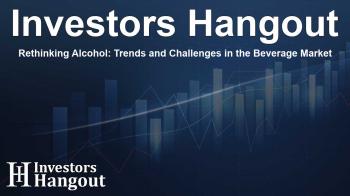Rethinking Alcohol: Trends and Challenges in the Beverage Market

Understanding the Current Challenges in the Alcohol Sector
The alcohol industry faces numerous challenges in recent years, marked by evolving consumer behaviors and economic pressures. This article delves into the factors reshaping the landscape of alcoholic beverages and explores potential future trends.
The Rise of Sober Movements
Every New Year, many people pledge to modify their habits, with initiatives like "Dry January" gaining traction among those looking to cut back on alcohol consumption. This annual challenge has emerged as a significant influencer on drinking patterns, prompting a change in how people view and engage with alcohol.
Impact of the Sober Curious Movement
As the Dry January movement continues to grow in popularity, many individuals find themselves extending their commitment beyond just the month of January. The trend towards moderation can be attributed to a shift among younger generations, who increasingly embrace the benefits of reduced alcohol intake. Trends indicate that 22% of adults participated in Dry January recently, highlighting a significant cultural shift.
Changing Trends in Alcohol Consumption
Historically, the alcohol sector has experienced steady growth, but recent years have seen a decline in overall alcohol consumption. Major sources highlight that beer, wine, and spirits volumes dropped by 2.6% in 2023, with forecasts predicting stagnation until at least 2029. Notably, sectors such as craft beer are witnessing prolonged decreases in popularity.
Shifts in Consumer Preferences
Consumer attitudes have shifted dramatically. A recent survey revealed that 45% of Americans now consider even moderate drinking as harmful, reflecting a significant change in social attitudes towards alcohol. Furthermore, younger demographics show a marked decline in regular alcohol consumption compared to their predecessors.
Market Dynamics and Economic Influences
As economic factors like inflation and supply chain issues come to the forefront, the alcohol industry must adapt or face further challenges. Rising prices across the board are prompting consumers to either scale back their alcohol purchases or seek more affordable options.
Simultaneously, the emergence of GLP-1 medications, which can suppress cravings, poses another layer of complexity. Approximately 12% of drinkers are reportedly using these treatments, adding another dynamic to the evolving market.
Supply Chain Challenges
Beyond consumer habits, supply chain disruptions have significantly impacted production and distribution capabilities. Shipping delays and shortages of essential materials are limiting product availability while driving up costs, forcing companies to respond strategically to protect their market position.
The Future Landscape of the Alcohol Industry
The path forward for the alcohol industry involves several key strategies. Companies are increasingly focusing on premiumisation—offering high-quality products at elevated prices. This strategy allows brands to maintain profitability by selling fewer volumes but at higher margins.
Diversifying Product Offerings
Innovation in product development is set to gain momentum as the demand for non-alcoholic and low-alcohol beverages rises. Major players are investing heavily in technology to replicate the taste and experience of their alcoholic counterparts while diversifying their offerings with healthier alternatives.
In recent developments, Molson Coors has seen impressive growth in its alcohol-free beer segment, with sales soaring by 89% over recent months. This indicates that consumers are increasingly seeking options that align with health-conscious lifestyles.
Conclusion: The Alcohol Industry’s Next Steps
Ultimately, the alcohol industry's future will depend significantly on how it adapts to changing consumer preferences and external pressures. While there are many hurdles ahead, the potential for growth in premium and non-alcoholic markets offers a glimmer of hope. By embracing these trends and refining their product offerings, companies can position themselves for success in this evolving landscape.
Frequently Asked Questions
What are the main factors contributing to the decline in alcohol sales?
The decline in alcohol sales can be attributed to changing consumer habits, economic pressures, and the growing popularity of movements like Dry January.
How has the perception of moderate drinking changed in recent years?
More Americans now see moderate drinking as harmful to health compared to previous decades; this reflects broader cultural shifts towards health awareness.
What role do GLP-1 medications play in alcohol consumption trends?
GLP-1 medications are reported to suppress appetite and cravings for alcohol, potentially impacting drinking patterns among certain demographics.
How are companies responding to challenges in the alcohol market?
Liquor companies are exploring strategies like premiumisation and diversifying product lines to adapt to market changes and consumer preferences.
What is premiumisation in the alcohol industry?
Premiumisation is a strategy used by alcohol brands to focus on selling higher-quality products at elevated prices, thus enhancing margins while managing volume challenges.
About The Author
Contact Dylan Bailey privately here. Or send an email with ATTN: Dylan Bailey as the subject to contact@investorshangout.com.
About Investors Hangout
Investors Hangout is a leading online stock forum for financial discussion and learning, offering a wide range of free tools and resources. It draws in traders of all levels, who exchange market knowledge, investigate trading tactics, and keep an eye on industry developments in real time. Featuring financial articles, stock message boards, quotes, charts, company profiles, and live news updates. Through cooperative learning and a wealth of informational resources, it helps users from novices creating their first portfolios to experts honing their techniques. Join Investors Hangout today: https://investorshangout.com/
The content of this article is based on factual, publicly available information and does not represent legal, financial, or investment advice. Investors Hangout does not offer financial advice, and the author is not a licensed financial advisor. Consult a qualified advisor before making any financial or investment decisions based on this article. This article should not be considered advice to purchase, sell, or hold any securities or other investments. If any of the material provided here is inaccurate, please contact us for corrections.

